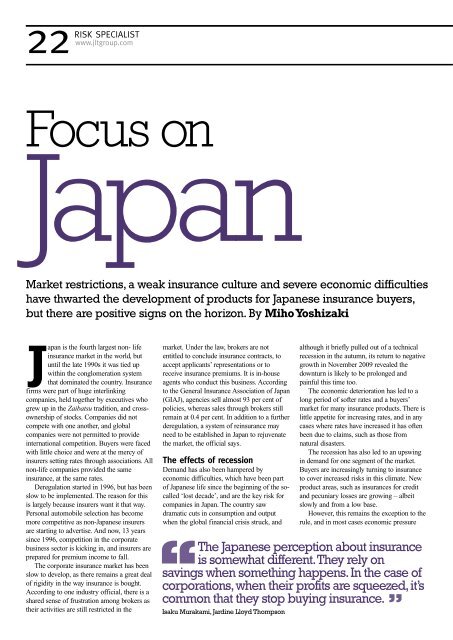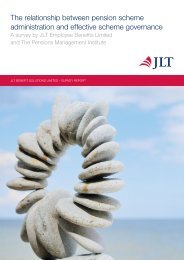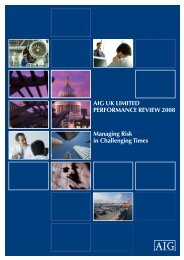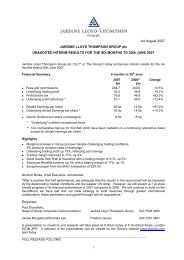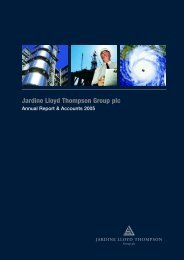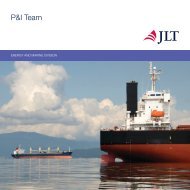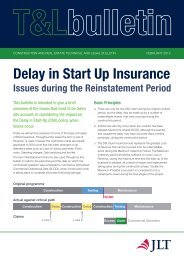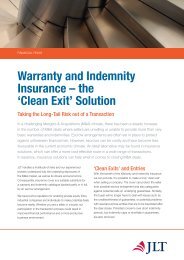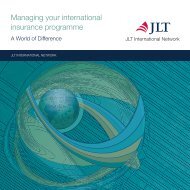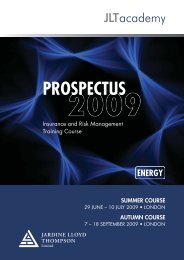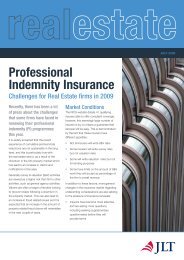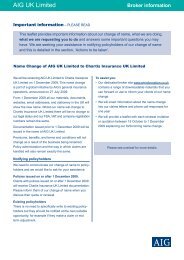Focus on Japan - JLT
Focus on Japan - JLT
Focus on Japan - JLT
You also want an ePaper? Increase the reach of your titles
YUMPU automatically turns print PDFs into web optimized ePapers that Google loves.
SPECIALIST<br />
www.jltgroup.com<br />
22RISK<br />
<str<strong>on</strong>g>Focus</str<strong>on</strong>g> <strong>on</strong><br />
<strong>Japan</strong><br />
Market restricti<strong>on</strong>s, a weak insurance culture and severe ec<strong>on</strong>omic difficulties<br />
have thwarted the development of products for <strong>Japan</strong>ese insurance buyers,<br />
but there are positive signs <strong>on</strong> the horiz<strong>on</strong>. By Miho Yoshizaki<br />
<strong>Japan</strong> is the fourth largest n<strong>on</strong>- life<br />
insurance market in the world, but<br />
until the late 1990s it was tied up<br />
within the c<strong>on</strong>glomerati<strong>on</strong> system<br />
that dominated the country. Insurance<br />
firms were part of huge interlinking<br />
companies, held together by executives who<br />
grew up in the Zaibatsu traditi<strong>on</strong>, and crossownership<br />
of stocks. Companies did not<br />
compete with <strong>on</strong>e another, and global<br />
companies were not permitted to provide<br />
internati<strong>on</strong>al competiti<strong>on</strong>. Buyers were faced<br />
with little choice and were at the mercy of<br />
insurers setting rates through associati<strong>on</strong>s. All<br />
n<strong>on</strong>-life companies provided the same<br />
insurance, at the same rates.<br />
Deregulati<strong>on</strong> started in 1996, but has been<br />
slow to be implemented. The reas<strong>on</strong> for this<br />
is largely because insurers want it that way.<br />
Pers<strong>on</strong>al automobile selecti<strong>on</strong> has become<br />
more competitive as n<strong>on</strong>-<strong>Japan</strong>ese insurers<br />
are starting to advertise. And now, 13 years<br />
since 1996, competiti<strong>on</strong> in the corporate<br />
business sector is kicking in, and insurers are<br />
prepared for premium income to fall.<br />
The corporate insurance market has been<br />
slow to develop, as there remains a great deal<br />
of rigidity in the way insurance is bought.<br />
According to <strong>on</strong>e industry official, there is a<br />
shared sense of frustrati<strong>on</strong> am<strong>on</strong>g brokers as<br />
their activities are still restricted in the<br />
market. Under the law, brokers are not<br />
entitled to c<strong>on</strong>clude insurance c<strong>on</strong>tracts, to<br />
accept applicants’ representati<strong>on</strong>s or to<br />
receive insurance premiums. It is in-house<br />
agents who c<strong>on</strong>duct this business. According<br />
to the General Insurance Associati<strong>on</strong> of <strong>Japan</strong><br />
(GIAJ), agencies sell almost 93 per cent of<br />
policies, whereas sales through brokers still<br />
remain at 0.4 per cent. In additi<strong>on</strong> to a further<br />
deregulati<strong>on</strong>, a system of reinsurance may<br />
need to be established in <strong>Japan</strong> to rejuvenate<br />
the market, the official says.<br />
The effects of recessi<strong>on</strong><br />
Demand has also been hampered by<br />
ec<strong>on</strong>omic difficulties, which have been part<br />
of <strong>Japan</strong>ese life since the beginning of the socalled<br />
‘lost decade’, and are the key risk for<br />
companies in <strong>Japan</strong>. The country saw<br />
dramatic cuts in c<strong>on</strong>sumpti<strong>on</strong> and output<br />
when the global financial crisis struck, and<br />
although it briefly pulled out of a technical<br />
recessi<strong>on</strong> in the autumn, its return to negative<br />
growth in November 2009 revealed the<br />
downturn is likely to be prol<strong>on</strong>ged and<br />
painful this time too.<br />
The ec<strong>on</strong>omic deteriorati<strong>on</strong> has led to a<br />
l<strong>on</strong>g period of softer rates and a buyers’<br />
market for many insurance products. There is<br />
little appetite for increasing rates, and in any<br />
cases where rates have increased it has often<br />
been due to claims, such as those from<br />
natural disasters.<br />
The recessi<strong>on</strong> has also led to an upswing<br />
in demand for <strong>on</strong>e segment of the market.<br />
Buyers are increasingly turning to insurance<br />
to cover increased risks in this climate. New<br />
product areas, such as insurances for credit<br />
and pecuniary losses are growing – albeit<br />
slowly and from a low base.<br />
However, this remains the excepti<strong>on</strong> to the<br />
rule, and in most cases ec<strong>on</strong>omic pressure<br />
The <strong>Japan</strong>ese percepti<strong>on</strong> about insurance<br />
is somewhat different. They rely <strong>on</strong><br />
savings when something happens. In the case of<br />
corporati<strong>on</strong>s, when their profits are squeezed, it’s<br />
comm<strong>on</strong> that they stop buying insurance.<br />
”<br />
Isaku Murakami, Jardine Lloyd Thomps<strong>on</strong>
FOCUS ON<br />
DECEMBER 2009<br />
JAPAN23<br />
The outlook for the<br />
insurance industry in<br />
<strong>Japan</strong> is promising<br />
IMAGES ©JNTO<br />
and its effect <strong>on</strong> budgets is leading buyers to<br />
take less insurance rather than more. Isaku<br />
Murakami, Director of Jardine Lloyd<br />
Thomps<strong>on</strong> <strong>Japan</strong> explains: “The <strong>Japan</strong>ese<br />
percepti<strong>on</strong> about insurance is somewhat<br />
different. They rely <strong>on</strong> savings when<br />
something happens. In the case of<br />
corporati<strong>on</strong>s, when their profits are squeezed,<br />
it’s a comm<strong>on</strong> pattern that they stop buying<br />
insurance policies.” So, it is important to<br />
introduce “the idea of risk management,” he<br />
says.<br />
Natural hazards<br />
It has been vital to address risks to the supply<br />
chain during the downturn. Supply chain<br />
management has been widely addressed<br />
within <strong>Japan</strong> since 1995 when the Great<br />
Hanshin Earthquake hit Kobe and shut down<br />
<strong>Japan</strong>’s largest port for 26 m<strong>on</strong>ths. However,<br />
the increased risk of business failures has<br />
encouraged a broad reassessment of risk.<br />
These risks have tended to be planned for<br />
rather than insured, but Mitsui Sumitomo<br />
Insurance, says insurances against business<br />
interrupti<strong>on</strong> risks are gaining importance.<br />
Buyers are also increasingly insuring<br />
against natural hazards. Regular earthquakes,<br />
and the memory of the Great Hanshin<br />
Earthquake are behind the rise. Karen<br />
Gorman, who coordinates global insurance<br />
programmes in L<strong>on</strong>d<strong>on</strong> as a Partner at<br />
Jardine Lloyd Thomps<strong>on</strong> says: “The main<br />
c<strong>on</strong>cern for our clients is the earthquake risk<br />
in certain regi<strong>on</strong>s and the sub-limits that<br />
insurers apply. In general, a global carrier will<br />
sublimit earthquake in <strong>Japan</strong> as a whole, and<br />
in some cases excess coverage will be sought<br />
from the market.”<br />
The percentage of people who added the<br />
earthquake insurance to their fire insurance<br />
policies has increased to 45 per cent in the<br />
fiscal year of 2008 compared with 33.3 per<br />
cent in the fiscal year 2002, the GIAJ says.<br />
Earthquake insurance is sold as an opti<strong>on</strong><br />
<strong>on</strong>ly <strong>on</strong> top of the fire insurances, and cannot<br />
be bought <strong>on</strong> its own.<br />
Changes <strong>on</strong> the horiz<strong>on</strong><br />
There are some changes <strong>on</strong> the horiz<strong>on</strong>,<br />
particularly with the Insurance Act coming<br />
into effect in April next year. It is designed to<br />
enhance the protecti<strong>on</strong> of policyholders’<br />
rights, update the language and improve the<br />
way insurance functi<strong>on</strong>s in order to help it<br />
work better in a modern globalised ec<strong>on</strong>omy.<br />
The Act is <strong>on</strong>e of the things aiding the role<br />
of L<strong>on</strong>d<strong>on</strong>’s insurance market, which has<br />
become increasingly important, allowing<br />
insurance to fit more easily into global<br />
programmes. Gorman says “more companies<br />
arrange insurance <strong>on</strong> a global basis and many<br />
of these global programmes include <strong>Japan</strong>.”<br />
Lloyd’s is keen to expand in the regi<strong>on</strong>. It<br />
has had a local licence since 1996 for a<br />
wholly owned subsidiary, through which »»
SPECIALIST<br />
www.jltgroup.com<br />
24RISK<br />
The main<br />
c<strong>on</strong>cern is the<br />
earthquake risk in<br />
certain regi<strong>on</strong>s and<br />
the sub-limits that<br />
insurers apply.<br />
”<br />
Karen Gorman, Jardine Lloyd Thomps<strong>on</strong><br />
IMAGES ©JNTO<br />
Competiti<strong>on</strong> in the <strong>Japan</strong>ese market is picking up<br />
a limited number of syndicates have been<br />
trading over the last ten years via a joint<br />
venture arrangement. Reinsurance can also be<br />
written through the subsidiary, although most<br />
of Lloyd’s reinsurance premium from <strong>Japan</strong> is<br />
currently written outside of it. In line with its<br />
strategy of growth in Asia, Lloyd’s is looking<br />
to expand in <strong>Japan</strong> and, in particular, to<br />
develop the subsidiary company into a<br />
flexible operating platform that will enable all<br />
managing agents to exploit fully Lloyd’s<br />
<strong>Japan</strong>ese trading licences and develop<br />
existing and new business opportunities.<br />
Looking ahead, there are opportunities for<br />
<strong>Japan</strong>ese n<strong>on</strong>-life insurance companies are<br />
accelerating merger activities for survival at<br />
the turn of its 150 years of history. Isaku<br />
Murakami, Director of Jardine Lloyd<br />
Thomps<strong>on</strong> <strong>Japan</strong> sees the main reas<strong>on</strong> for<br />
c<strong>on</strong>solidati<strong>on</strong> is in “reducing costs,” as the<br />
fixed rate system before the deregulati<strong>on</strong><br />
of the late 1990s discouraged<br />
competitiveness in the industry. By April<br />
2010, the insurance market will be shared<br />
by three major players.<br />
Mitsui Sumitomo Insurance Group<br />
Holdings has announced it is teaming up<br />
with Aioi Insurance and Nissay Dowa<br />
General Insurance, <strong>Japan</strong>’s number three,<br />
four and six respectively, to merge under a<br />
holding company MS&AD Insurance Group<br />
Holdings. MS&AD will be the biggest<br />
<strong>Japan</strong>ese n<strong>on</strong>-life insurance company with<br />
<strong>Japan</strong>’s n<strong>on</strong>-life insurance market, as the<br />
export-driven ec<strong>on</strong>omy is slowly emerging<br />
out from recessi<strong>on</strong>. The Internati<strong>on</strong>al<br />
M<strong>on</strong>etary Fund (IMF) expects <strong>Japan</strong>’s<br />
gradual recovery will materialise to a 1.7 per<br />
cent growth in 2010. <strong>Japan</strong>ese corporate<br />
bankruptcies are falling too. The number of<br />
<strong>Japan</strong>ese business failures declined in<br />
October for a third straight m<strong>on</strong>th from a year<br />
earlier to 1,261 cases, according to Tokyo<br />
Shoko Research.<br />
There are also changes within the<br />
insurance culture in operati<strong>on</strong>. Increasing<br />
globalisati<strong>on</strong> of business means <strong>Japan</strong>ese<br />
CONSOLIDATION IN THE INSURANCE MARKET<br />
the combined net premiums of ¥2.4 trilli<strong>on</strong><br />
for the financial year to March 2009,<br />
overtaking the current market leader Tokio<br />
Marine Holdings.<br />
Meanwhile the sec<strong>on</strong>d largest Sompo<br />
<strong>Japan</strong> Insurance and the number five<br />
Nipp<strong>on</strong>koa Insurance have also announced<br />
a merger plan to create NKSJ Holdings<br />
with ¥1.9 trilli<strong>on</strong> worth of net premiums.<br />
According to <strong>Japan</strong>’s Financial Services<br />
Agency (FSA), which oversees n<strong>on</strong>-life<br />
insurers, the six largest companies hold<br />
over 80 per cent of the ¥7.4 trilli<strong>on</strong><br />
market. The rest of the market shares are<br />
pecked by much smaller rivals such as<br />
Kyoei Fire & Marine Insurance, and Fuji Fire<br />
and Marine Insurance, which is more than<br />
40 per cent owned by American<br />
Internati<strong>on</strong>al Group.<br />
managers are seeing the way insurance<br />
products and markets help their overseas<br />
counterparts – particularly with pressing issues<br />
such as ec<strong>on</strong>omic instability and supply chain<br />
problems, and are implementing insurance<br />
soluti<strong>on</strong>s to handle it. According to Mitsui<br />
Sumitomo Insurance, <strong>on</strong>e of the areas seeing<br />
particular growth is liability insurance <strong>on</strong> the<br />
back of the fact that the current risks are<br />
becoming more diverse in an increasingly<br />
complex world.<br />
Future progress<br />
But there is a l<strong>on</strong>g way to go. Nobuyuki<br />
Akahane, a Development Executive for Jardine<br />
Lloyd Thomps<strong>on</strong> in L<strong>on</strong>d<strong>on</strong>, points out that<br />
<strong>Japan</strong>’s n<strong>on</strong>-life insurance market is heavily<br />
relying <strong>on</strong> ‘Ka-Ji-Sho’ products, a <strong>Japan</strong>ese<br />
acr<strong>on</strong>ym for fire, automobile and pers<strong>on</strong>al<br />
accident products, and the market is expected<br />
to shrink. “The <strong>Japan</strong>ese market structure is<br />
unique compared with other countries. If the<br />
product ratio was the same as the West, the<br />
<strong>Japan</strong>ese market would be much larger. It<br />
means that there is a potential for other<br />
products to grow, and the progress should be<br />
encouraged,” he says.<br />
While ec<strong>on</strong>omic problems and market<br />
restricti<strong>on</strong>s within <strong>Japan</strong> hamper the growth of<br />
both business and the insurance market,<br />
businesses will c<strong>on</strong>tinue to look overseas for<br />
opportunities elsewhere in the world. “I am<br />
seeing a recovery in overseas projects,” says<br />
Akahane, “projects in the Middle East and<br />
Asia are showing signs of recovery in the last<br />
2-3 m<strong>on</strong>ths.” RS<br />
i<br />
Isaku_Murakami@jltasia.com<br />
Miho Yoshizaki is a freelance journalist covering a<br />
range of <strong>Japan</strong>-related news.
25<br />
FOCUS ON JAPAN<br />
DECEMBER 2009<br />
<strong>Japan</strong>’s<br />
risk rating<br />
Legal and<br />
regulatory risk<br />
Strikes, riots and<br />
civil commoti<strong>on</strong><br />
Terrorism<br />
Overall <strong>Japan</strong> has a relatively benign<br />
risk profile. However, there is <strong>on</strong>e<br />
particularly striking excepti<strong>on</strong>:<br />
ec<strong>on</strong>omic risk. Recessi<strong>on</strong> and deflati<strong>on</strong> have<br />
brought serious c<strong>on</strong>cerns for both businesses<br />
and a government forced to rapidly increase<br />
borrowing. Structural imbalances in the<br />
country have exacerbated these issues, with a<br />
shortage of natural resources and an ageing<br />
populati<strong>on</strong> hampering the resp<strong>on</strong>se.<br />
Elizabeth Stephens, Head of Credit &<br />
Political Risk Analysis at Jardine Lloyd<br />
Thomps<strong>on</strong> explains: “<strong>Japan</strong> has suffered<br />
from deflati<strong>on</strong>, exports have fallen 26 per<br />
cent and there has been a 15 per cent drop in<br />
GDP over the past 12 m<strong>on</strong>ths. The ec<strong>on</strong>omy<br />
isn’t in that great shape.” <strong>Japan</strong> is, in fact,<br />
expected to be overtaken by China as the<br />
sec<strong>on</strong>d largest ec<strong>on</strong>omy in the world by the<br />
end of 2010. All these factors are reflected in<br />
an ec<strong>on</strong>omic risk rating of 5.<br />
The World Risk Review compares<br />
countries in terms of how well placed they<br />
are to deal with ec<strong>on</strong>omic challenges, as well<br />
as where they are in the ec<strong>on</strong>omic cycle.<br />
<strong>Japan</strong> is struggling here too. Problems are<br />
compounded by structural issues, including<br />
an ageing populati<strong>on</strong>, which gives it little<br />
room for manoeuvre, and a shortage of<br />
natural resources. Some 96 per cent of these<br />
have to be imported. Stephens explains:<br />
“There is talk of allowing the yen to<br />
appreciate. It has been traditi<strong>on</strong>ally thought<br />
to be too difficult, as it would increase the<br />
cost of exports, but it is being c<strong>on</strong>sidered in<br />
order to bring down the price of imports.”<br />
In an effort to deal with ec<strong>on</strong>omic<br />
problems, <strong>Japan</strong>, like many other OECD<br />
countries has taken <strong>on</strong> a lot of debt, resulting<br />
in a downgrading by Moody’s in the<br />
summer. This has raised the sovereign credit<br />
risk rating to 2. Stephens says: “The<br />
ec<strong>on</strong>omy isn’t going to crash like Iceland,<br />
but it will take a l<strong>on</strong>g time to rebound.” The<br />
new government has also promised to<br />
increase spending, which has raised c<strong>on</strong>cerns<br />
of how it will be paid for. “It may be through<br />
more borrowing or more taxes, so businesses<br />
are also c<strong>on</strong>cerned about possible tax<br />
increases.”<br />
C<strong>on</strong>tract<br />
agreement<br />
repudiati<strong>on</strong><br />
Expropriati<strong>on</strong><br />
Sovereign<br />
credit risk<br />
Bey<strong>on</strong>d the ec<strong>on</strong>omy, the next risk is the<br />
threat of strikes, riots and civil commoti<strong>on</strong>,<br />
rated as 2. Stephens says these are not an<br />
imminent danger. However: “There were<br />
dem<strong>on</strong>strati<strong>on</strong>s in the run up to the electi<strong>on</strong>,<br />
and there are also labour reforms which have<br />
to be passed.” The country also faces tensi<strong>on</strong><br />
over immigrati<strong>on</strong> and has a history of ultranati<strong>on</strong>alist<br />
disturbances, but as Stephens<br />
says: “This is a h<strong>on</strong>eymo<strong>on</strong> period for the<br />
new government, so tensi<strong>on</strong>s died down.”<br />
World Risk Review <br />
The World Risk Review <br />
provides short- to mediumterm<br />
assessments of the<br />
level of risk associated with<br />
a range of political and<br />
ec<strong>on</strong>omic perils that may<br />
impact up<strong>on</strong> business.<br />
The risk review rates nine<br />
perils in 197 countries and<br />
territories, captured under<br />
the broad categories of<br />
political violence, the trading<br />
envir<strong>on</strong>ment and the<br />
investment envir<strong>on</strong>ment.<br />
The model is designed to<br />
enable companies to<br />
2<br />
2<br />
1<br />
2 1<br />
2<br />
1<br />
effectively identify the perils<br />
that may impact <strong>on</strong> their<br />
business and deliver an<br />
understanding of the relative<br />
level of risk associated with<br />
each peril, using a scale of 1<br />
(low) to 10 (high).<br />
The model incorporates<br />
independently verifiable<br />
data from 53 internati<strong>on</strong>al<br />
sources, drawn from Europe,<br />
North America, Australia, Asia<br />
and the Middle East.<br />
The diversity and breadth<br />
of the data sources is<br />
intended to reduce, to the<br />
Currency<br />
inc<strong>on</strong>vertability<br />
and transfer risk<br />
World Risk Review ratings for <strong>Japan</strong><br />
TM<br />
War and civil war<br />
Country<br />
ec<strong>on</strong>omic risk<br />
War has a rating of 2, as there are<br />
tensi<strong>on</strong>s with North Korea. Stephens says:<br />
“<strong>Japan</strong> is nervous that North Korea is<br />
testing nuclear weap<strong>on</strong>s, although under the<br />
leadership of Kim J<strong>on</strong>g-il the country is<br />
very good at escalating tensi<strong>on</strong>s and then<br />
stepping back from the brink.”<br />
Other risks with a rating of 2, such as<br />
regulatory risk, are partly due to the<br />
electi<strong>on</strong> of a new government which raised<br />
the likelihood of changing regulati<strong>on</strong>. RS<br />
greatest extent possible,<br />
cultural bias, political<br />
influence and pers<strong>on</strong>al<br />
interpretati<strong>on</strong>.<br />
This approach c<strong>on</strong>tributes<br />
significantly to the<br />
robustness and integrity of<br />
the model and recognises<br />
that most country risk ratings<br />
available to the business<br />
have traditi<strong>on</strong>ally been<br />
heavily influenced by western<br />
bias reflecting the historical<br />
dominance of western<br />
foreign investors and trading<br />
businesses.<br />
For more details and to register for this free service go to www.jltgroup.com/worldriskreview<br />
2<br />
5


